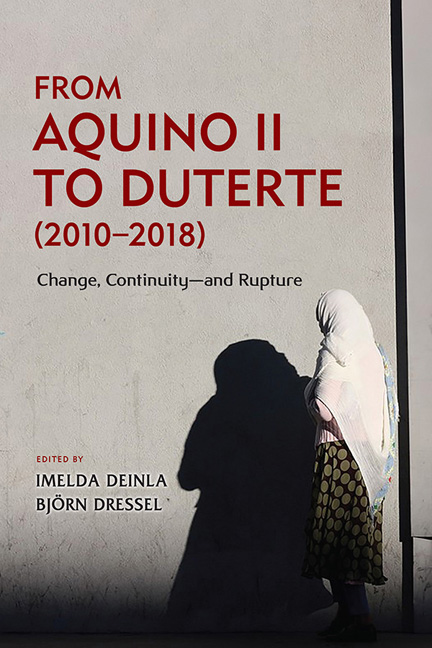Book contents
- Frontmatter
- Contents
- List of Tables
- List of Figures
- Acknowledgements
- Acronyms and Glossary
- Contributors
- Introduction: From Aquino II to Duterte (2010–2018): Change, Continuity—and Rupture 1
- PART I POLITICS AND GOVERNANCE
- PART II ECONOMIC GOVERNANCE
- PART III PEACE PROCESS IN MINDANAO
- PART IV INTERNATIONAL ENVIRONMENT
- Index
Introduction: From Aquino II to Duterte (2010–2018): Change, Continuity—and Rupture 1
Published online by Cambridge University Press: 31 January 2020
- Frontmatter
- Contents
- List of Tables
- List of Figures
- Acknowledgements
- Acronyms and Glossary
- Contributors
- Introduction: From Aquino II to Duterte (2010–2018): Change, Continuity—and Rupture 1
- PART I POLITICS AND GOVERNANCE
- PART II ECONOMIC GOVERNANCE
- PART III PEACE PROCESS IN MINDANAO
- PART IV INTERNATIONAL ENVIRONMENT
- Index
Summary
Democratic practices of the Philippines, Asia's oldest democracy and the second most populous country in the ASEAN region, have been a puzzle to many scholars and observers of democracy. While vibrant in terms of voter turnout, civic engagement, and institutional protections, there are widespread flaws in Philippine democratic processes—illustrated by persistent pernicious elite politics, continued institutional weakness, and widespread abuse of public office.
The country's economic record is as patchy as its democracy. The long-standing description of the Philippines as the “sick man of Asia” has been rebutted by the country's rapid economic growth over the last decade (2007–17). However, with regular boom and bust cycles, and persistent deep-seated poverty and inequality, concerns remain about the equity and sustainability of this type of growth in the Philippines. Built on the legacies of Spanish and United States colonial rule, the Philippine state remains confronted by constant challenges to its legitimacy—including Asia's longest communist rebellion, Muslim separatist insurgencies in Mindanao, and large-scale public protests such as the first and second Epifanio de los Santos Avenue (EDSA 1 and 2), Philippine's People Power Revolution that forced changes in leadership through extra-constitutional processes.
“Change” has therefore been a recurring theme in Philippine political, economic, and social discourses. The discourse of change holds considerable appeal and permeates the everyday lives of ordinary Filipinos with remarkable intensity and frequency. The discourse informs the thinking of political observers who identify competing reformist and populist narratives of change in Philippine politics. Change seems to characterize the transition from the administration of Aquino II (2010–16) to the administration of current president Rodrigo Roa Duterte (2016–). Aquino II was elected on a technocratic “straight path” (daang matuwid) reform platform that challenged the widespread abuse of public office under the presidency of Gloria Macapagal Arroyo (2001–10). Duterte—a maverick former mayor of Davao city in Mindanao—rode high on a campaign promise in the 2016 presidential election of bringing about law and order in a swift and decisive manner, embodied in his slogan “Change Is Coming”.
But how much change has actually taken place? What kind of change is unfolding and for whom? Are we simply witnessing business-as-usual, fragmented Filipino elite politics, as a feature of discordant democracy in the Philippines?
- Type
- Chapter
- Information
- From Aquino II to Duterte (2010–2018)Change, Continuity—and Rupture, pp. 1 - 36Publisher: ISEAS–Yusof Ishak InstitutePrint publication year: 2019



